英语语法名词讲解
英语语法名词内容全概括(详细版)
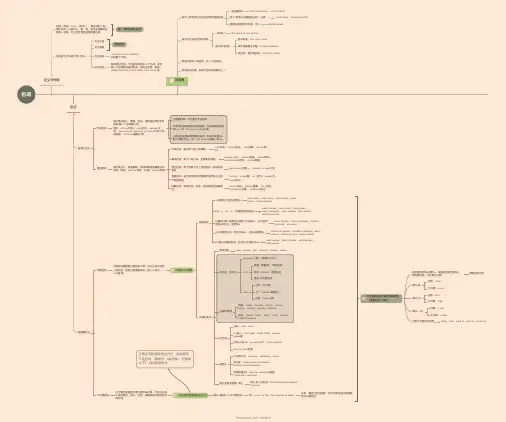
名词定义与作用区分按意义区分按数量区分专有名词表示具体的人,事物,地点,团体或机构的专有名称(第一个字母要大写)例如:China(中国)、Asia(亚洲)、Beijing(北京)、the People’s Republic of China(中华人民共和国)、Sunday(星期日)等。
普通名词表示某些人,某类事物,某种物质或抽象概念的名称。
例如:teacher老师、tea茶、reform改革所有格个体名词:表示单个的人和事物。
集体名词:表示一群人或一些事物的名称。
car(汽车)、room(房间)、 fan(风扇)、photo(照片)③姓氏名如果采用复数的形式,则表示该姓氏一家人(复数含义)。
如:the Greens(格林一家人)②专有名词如果含有名词短语,则必须使用定冠词the。
如:the Great Wall(长城)①星期的每一天也属于专有名词p eople(人们)、family(家庭)、army(军队)、g overnment(政府)、group(集团)复合名词:两个或两个以上名词连在一起构成的名词p asser-by(过路人)、brother-in-law(内兄)物质名词:表示物质或不具备确定形状和大小的个体的物质。
fire(火)、steel(钢)、air (空气)、water(水)、m ilk(牛奶)抽象名词:表示动作,状态,品质或其它抽象概念。
l abor( 劳动)、health(健康)、life (生活)、f riendship(友情)、patience(耐力)可数名词不可数名词可数名词是指能以数目来计算,可以分成个体的人或东西,因此它有复数形式。
如cup(杯子),c at(猫)等。
不可数名词是指不能以数目来计算,不可以分成个体的概念、状态、品质、感情或表示物质材料的东西可数名词变复数规则变化以f或fe结尾的名词,把f或fe去掉改为vesl eaf-leaves、thief-thieves、wolf-wolves、w ife-wives以o结尾的名词,有生命加es,无生命直接加s以辅音字母y结尾的名词变y为i再加es,以元音字母加y的名词,直接加ss tory-stories、family-families、factory-f actories、boy-boys以s、x、ch、sh、结尾的名词后加esc lass-classes、bus-buses、box-boxes、b each-beaches、wish-wishes、dish-dishes、w atch-watches一般情况下在名词后加sb ag-bags、year-years、map-maps、desk-d esks、friend-friends不规则变化单复同形含元音某国人d eer、sheep、fish、species、means、seriesa变e:man、meno o变ee:foot-feet、tooth-teeth、goose-g eese鹅后有en或ren:ox-oxen公牛、child-childrenm ouse-mice老鼠中日瑞不变:Chinese、Japanese、Swiss英法变:Frenchman-Frenchmen、E nglishman-Englishmen其余后面加s:German-Germans德国、A merican-Americans复合名词变复数(略)男人女人加名词:woman teacher-woment eachersp otato-potatoes、tomato-tomatoes、hero-h eroes、photo-photos、piano-pianos意不同、形不同p eople人(复)/民族peoplesf ish条数(单复同)可数名词;种类(fishes)可数名词鱼肉不可数名词w ork工作(不可数)工厂(works 单复同)作品(works 复)只能作复数双的:pants、trousers、shorts、shoes、s ocks、gloves、glasses、scissors特定:thanks、tears、twins、arms、clothes、c ongratulations不可数名词的数量表达方式数次+量词+of+不可数名词如:a cup of tea、two glasses of water注意:量词可变为复数,但不可数名词没有复数形式不做变化不可数名词与可数名词的修饰(答题区分小技巧)前面是否有加a或者an,或者后面是否有加s。
语法点-英语名词讲解
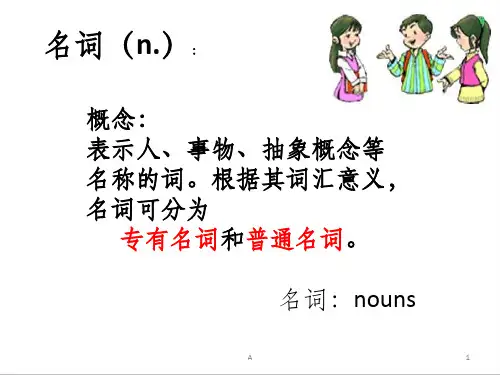
A
15
注意:
与man、woman两个词组成的复合词, 名词本身和这个词都要变成复数。
如: Woman doctor/ women doctors Man worker/ men workers Man driver/ men drivers
A
16
注意:
复合名词变复数通常是将其主要名 词变为复数: passer-by / passers-by 过路人 looker-on / lookers-on 旁观者
A
8
记住以下10个要把f或者fe改成 v加es的单词: wife(妻子),life(生命),knife(小 刀),leaf(树叶),thief(贼), half(一半),self(自己),shelf(架 子),loaf(面包),wolf(狼)。
但roof-roofs(屋顶)是例外!!
A
9
(5) 以“辅音字母+o”结尾的名词,加词尾 es;如tomato- tomatoes; potatopotatoes ; hero(英雄)-heroes
mouse / mice 老鼠
ox / oxen 公牛
A
14
注意:
1、一些以 man, woman 结尾的合成 词,在构成复数时与 man, woman 的 变化形式相同,如: policeman / policemen(警察), Englishman / Englishmen (英国人), Frenchman/ Frenchmen(法国人)
(2) 以 s, x, sh, ch 等结尾的名词,通常加词 尾 -es:bus -buses, box -boxes, dish-dishes, match-matches(比赛),watch-watches等。
英语语法知识之名词
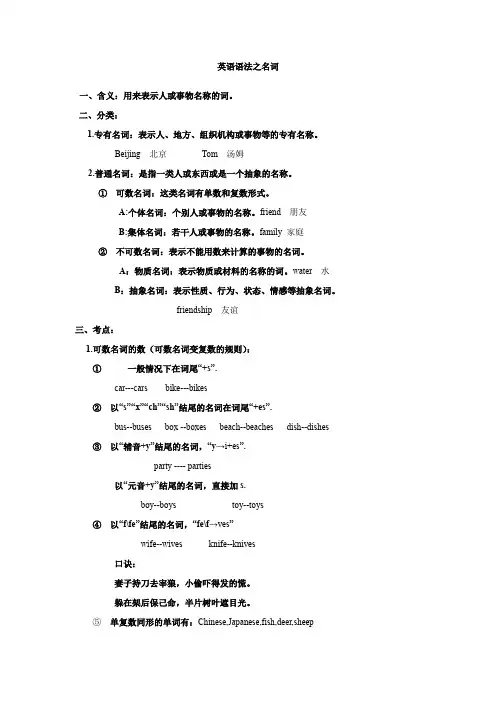
英语语法之名词一、含义:用来表示人或事物名称的词。
二、分类:1.专有名词:表示人、地方、组织机构或事物等的专有名称。
Beijing 北京Tom 汤姆2.普通名词:是指一类人或东西或是一个抽象的名称。
①可数名词:这类名词有单数和复数形式。
A:个体名词:个别人或事物的名称。
friend 朋友B:集体名词:若干人或事物的名称。
family 家庭②不可数名词:表示不能用数来计算的事物的名词。
A:物质名词:表示物质或材料的名称的词。
water 水B:抽象名词:表示性质、行为、状态、情感等抽象名词。
friendship 友谊三、考点:1.可数名词的数(可数名词变复数的规则):①一般情况下在词尾“+s”.car---cars bike---bikes②以“s”“x”“ch”“sh”结尾的名词在词尾“+es”.bus--buses box --boxes beach--beaches dish--dishes③以“辅音+y”结尾的名词,“y→i+es”.party ---- parties以“元音+y”结尾的名词,直接加s.boy--boys toy--toys④以“f\fe”结尾的名词,“fe\f→ves”wife--wives knife--knives口诀:妻子持刀去宰狼,小偷吓得发的慌。
躲在架后保己命,半片树叶遮目光。
⑤单复数同形的单词有:Chinese,Japanese,fish,deer,sheep口诀:中日人民爱护鱼鹿羊。
⑥某国人变复数:Chinese ChineseJapanese JapaneseEnglishman EnglishmenFrenchman FrenchmenGerman GermansAmerican AmericansAustralian Australians 口诀:中日不变英法变,其余后面加s.⑦以o结尾的单词,加es的常见的只有5个:Negro,hero,potato,tomato,mango口诀:黑人、英雄、爱吃土豆、西红柿、芒果⑧变化单次内部元音字母man menwoman womenpoliceman policemenEnglishman EnglishmenFrenchman Frenchmenfoot feettooth teethgoose geese⑨特殊变化的有:child childrenthis thesethat thoseshe\he\it theyam\is areI weyou you2.名词所有格①概念:表示所有关系的名词形式,译作“……的”。
英语语法大全之——名词
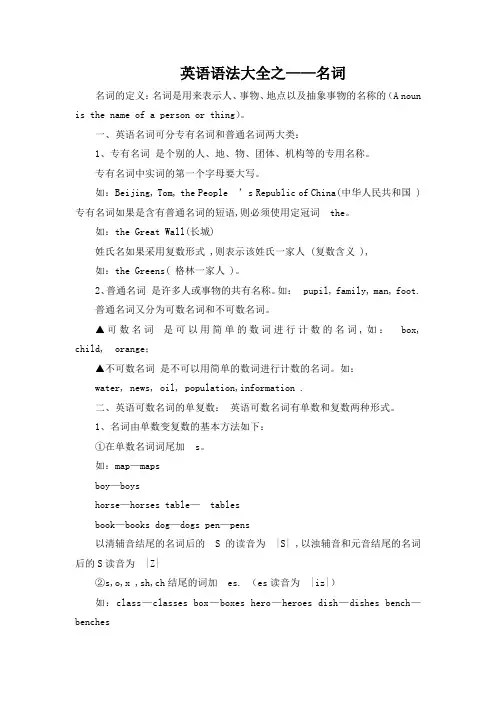
英语语法大全之——名词名词的定义:名词是用来表示人、事物、地点以及抽象事物的名称的(A noun is the name of a person or thing)。
一、英语名词可分专有名词和普通名词两大类:1、专有名词是个别的人、地、物、团体、机构等的专用名称。
专有名词中实词的第一个字母要大写。
如:Beijing, Tom, the People ’s Republic of China(中华人民共和国 )专有名词如果是含有普通名词的短语,则必须使用定冠词the。
如:the Great Wall(长城)姓氏名如果采用复数形式 ,则表示该姓氏一家人 (复数含义 ),如:the Greens( 格林一家人 )。
2、普通名词是许多人或事物的共有名称。
如:pupil, family, man, foot.普通名词又分为可数名词和不可数名词。
▲可数名词是可以用简单的数词进行计数的名词,如:box, child, orange;▲不可数名词是不可以用简单的数词进行计数的名词。
如:water, news, oil, population,information .二、英语可数名词的单复数:英语可数名词有单数和复数两种形式。
1、名词由单数变复数的基本方法如下:①在单数名词词尾加s。
如:map—mapsboy—boyshorse—horses table—tablesbook—books dog—dogs pen—pens以清辅音结尾的名词后的S的读音为|S| ,以浊辅音和元音结尾的名词后的S读音为|Z|②s,o,x ,sh,ch结尾的词加es. (es读音为|iz|)如:class—classes box—boxes hero—heroes dish—dishes bench—benchesbus—buses brush—brushes[注]:少数以元音字母o 结尾的名词 ,变复数时直接在词尾 +s。
如:photo—photos piano—pianos radio—radios(但Negro、hero、potato、tomato、mango、mosquito均+es,其他+s) 黑人、英雄、土豆、西红柿、芒果、蚊子③以辅音字母 +y 结尾的名词 ,变y 为i,再加 es。
【英语】英语基础语法知识介绍名词
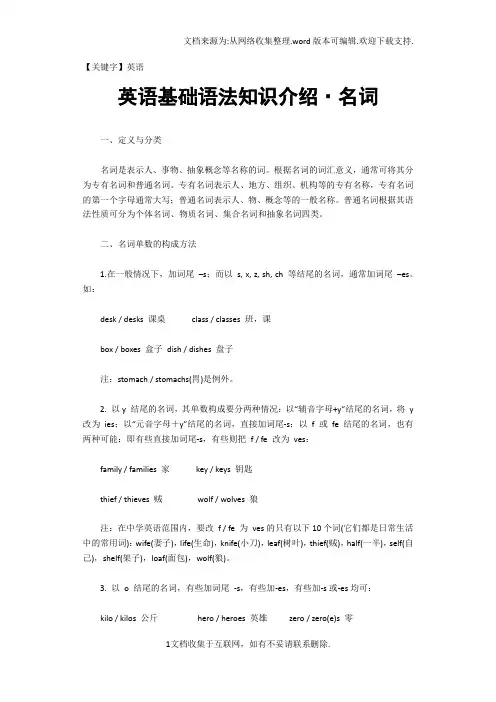
【关键字】英语英语基础语法知识介绍·名词一、定义与分类名词是表示人、事物、抽象概念等名称的词。
根据名词的词汇意义,通常可将其分为专有名词和普通名词。
专有名词表示人、地方、组织、机构等的专有名称,专有名词的第一个字母通常大写;普通名词表示人、物、概念等的一般名称。
普通名词根据其语法性质可分为个体名词、物质名词、集合名词和抽象名词四类。
二、名词单数的构成方法1.在一般情况下,加词尾–s;而以s, x, z, sh, ch 等结尾的名词,通常加词尾–es。
如:desk / desks 课桌class / classes 班,课box / boxes 盒子dish / dishes 盘子注:stomach / stomachs(胃)是例外。
2. 以y 结尾的名词,其单数构成要分两种情况:以“辅音字母+y”结尾的名词,将y 改为ies;以“元音字母+y”结尾的名词,直接加词尾-s;以 f 或fe 结尾的名词,也有两种可能:即有些直接加词尾-s,有些则把f / fe 改为ves:family / families 家key / keys 钥匙thief / thieves 贼wolf / wolves 狼注:在中学英语范围内,要改f / fe 为ves的只有以下10个词(它们都是日常生活中的常用词):wife(妻子),life(生命),knife(小刀),leaf(树叶),thief(贼),half(一半),self(自己),shelf(架子),loaf(面包),wolf(狼)。
3. 以o 结尾的名词,有些加词尾-s,有些加-es,有些加-s或-es均可:kilo / kilos 公斤hero / heroes 英雄zero / zero(e)s 零注:在中学英语范围内,加词尾-es 的主要有以下4个:tomato(西红柿),potato(土豆),hero(英雄),Negro(黑人)。
三、单数与单数同形的名词sheep 绵羊fish 鱼deer 鹿Chinese 中国人Japanese 日本人Portuguese 葡萄牙人Swiss 瑞士人aircraft 飞行器means 方法series 系列head (牛等的)头数works 工厂注:fish 有时也用fishes 这样的单数形式,尤其是表示种类时;head 若不是表示牲口的“头数”,而是表示“人的头”或“人数”,则要用heads 这样的单数形式。
英语语法名词词性讲解
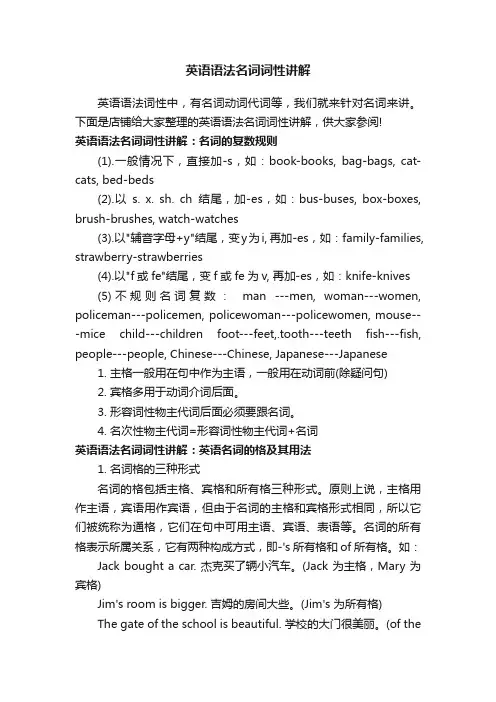
英语语法名词词性讲解英语语法词性中,有名词动词代词等,我们就来针对名词来讲。
下面是店铺给大家整理的英语语法名词词性讲解,供大家参阅!英语语法名词词性讲解:名词的复数规则(1).一般情况下,直接加-s,如:book-books, bag-bags, cat-cats, bed-beds(2).以s. x. sh. ch结尾,加-es,如:bus-buses, box-boxes, brush-brushes, watch-watches(3).以"辅音字母+y"结尾,变y为i, 再加-es,如:family-families, strawberry-strawberries(4).以"f或fe"结尾,变f或fe为v, 再加-es,如:knife-knives(5)不规则名词复数:man ---men, woman---women, policeman---policemen, policewoman---policewomen, mouse---mice child---children foot---feet,.tooth---teeth fish---fish, people---people, Chinese---Chinese, Japanese---Japanese1. 主格一般用在句中作为主语,一般用在动词前(除疑问句)2. 宾格多用于动词介词后面。
3. 形容词性物主代词后面必须要跟名词。
4. 名次性物主代词=形容词性物主代词+名词英语语法名词词性讲解:英语名词的格及其用法1. 名词格的三种形式名词的格包括主格、宾格和所有格三种形式。
原则上说,主格用作主语,宾语用作宾语,但由于名词的主格和宾格形式相同,所以它们被统称为通格,它们在句中可用主语、宾语、表语等。
名词的所有格表示所属关系,它有两种构成方式,即-'s 所有格和 of 所有格。
如:Jack bought a car. 杰克买了辆小汽车。
名词语法讲解
英语名词(Noun)一了解名词的分类总的来说,名词可以分为专有名词和普通名词。
一)专有名词是某个或某些人,地方,机构等专有的名称,注意这类词的中心词的第一个字母要大写。
如:China, Chinese, Jim, Li hua, New York, Shanghai,the Great Wall,To Kill a Mockingbird《杀死一只知更鸟》等。
二)普通名词是一类人或东西或是一个抽象概念的名词,普通名词可分为下面四类:1 个体名词:表示某类人或东西中的个体,如:pen, student, desk, book, bike。
2 集体名词:表示若干个个体组成的集合体,如:family, class, people3 物质名词:表示无法分为个体的实物,如:air, water。
4 抽象名词:表示状态、品质、感情等抽象概念,如:work, time, news。
二名词的数物质名词和抽象名词一般无法用数目计算,称为不可数名词(Uncountable Nouns)一般没有复数形式,只有单数形式。
个体名词和集体名词一般可以用数目来计算,称为可数名词(Countable Nouns),因此它有复数形式。
常见的不可数名词:Information 信息;news 新闻;housework 家务;homework 家庭作业;juice 果汁;Tea 茶;waste 垃圾;废料;bread 面包;milk 牛奶;orange 橙汁;money 金钱;meat 肉;advice 建议;traffic 交通;peace 和平;anger 愤怒;courage 勇气;energy 能量;fear 恐惧;fun 乐趣;health 健康;weather 天气;happiness 幸福;help 帮助;honesty 诚实;justice 正义;knowledge 知识;laughter 笑声;liberty 自由;strength 力量;trouble 麻烦;truth 真理;air 空气;progress 进步;luggage 行李;science 科学;technology 技术;smoke 烟;equipment 设备;wealth 财富;富裕music 音乐;luck 运气;furniture 家具;attention 注意某些名词既可以作不可数名词,也可以作可数名词。
初一英语名词语法知识总结(讲解+考点+综合练习):名 词
第二章 名 词一、名词概述1、名词的定义:名词是指表示人、事、物、地点或抽象概念的词。
2、名词的种类:(1)普通名词: 表示一类人、事物或抽象概念的名称。
普通名词又可进一步分为四类:①个体名词: 表示单个的人和事物。
如car(汽车)、room(房间)、 fan(风 扇)、photo(照片)。
②集体名词: 表示一群人或一些事物的名称。
如 people(人们)、family(家 庭)、army(军队)、government(政府)、group(集团)。
③物质名词: 表示物质或不具备确定形状或大小的个体的物质。
如fire (火)、steal (钢)、air (空气)、water (水)、milk (牛奶)。
④抽象名词: 表示动作、状态、品质或其他抽象概念。
如 labor( 劳动)、 health(健康)、life (生活)、friendship(友情)、patience(耐力)。
(2)专有名词: 表示特定的人、地方、称谓、机构、语言、国民、星期、月份、 节日名称等,专有名词的第一个字母必须大写。
三、综合练习1.单项选择题()1. They got much _____ from those new books.A. ideasB. photosC. newsD. stories()2. I have two _______ and three bottles of _________ here.A. orange, orangeB. oranges, orangesC. oranges, orangeD. orange, oranges()3. Every evening Mr. King takes a _________ to his home .A. 25 minutes’ walkB. 25 minute’s walkC. 25 minute walkD. 25 minutes walk()4. An old _______ wants to see you.A. peopleB. personC. the peopleD. the person()5. Help yourself to __________.A. chickens and applesB. chickens and appleC. chicken and appleD. chicken and apples()6. Oh, dear. I forgot the two _________.A. roo m’s numberB. rooms’ numberC. room numbersD. rooms’ numbers()7. She has been in Tianjin for ten years. Tianjin has become her second _________.A. familyB. houseC. homeD. room()8. ________ mothers couldn’t go to the meeting, because they have gone to Shanghai .A. Mary and Peter’sB. Mary and PeterC. Mary’s and PeterD. Mary’s and Peter’s()9. Li Lei has been to __________ many times this month.A. her uncleB. her uncle’sC. her unclesD. aunt’s()10. He is a success as a leader but he hasn’t ________ in teaching.A. many experiencesB. much experienceC. an experienceD. a lot experience()11.______ are going to see a film.A. Green’sB. The Green’sC. The GreensD. The Green()12. Mrs. Green is ______mother.A. Lucy’s and Lily’sB. Lucy and Lily’sC. Lucy and LilyD. Lily’s a nd Lucy()13. Ben saw forty______in a cave.A. thiefesB. thievesC. thiefD. thiefs()14. Dongdong is one of the Chinese in our school.A. boyB. boysC. boiesD. boyes()15.This is the room.A. children’sB. childrens’C. childrenD. childrens()16. ---Is that ?---Yes, it is.A. a pair of glassB. two pair of glassesC. a pair of glassesD. glasses()17. Hong Wei is making a card. She wants a of scissors.A. packetB. bottleC. pairD. pairs()18. These bottles of are fresh.A. milkB. milksC. jamsD. milkes()19. A friend of will come this evening.A. Denny’sB. DennyC. Dennys’D. Dennys()20. This is a big room. It’s the .A. twin’s roomB. twins roomC. twins’ roomD. twin rooms()21. There are three and seven in the picture.A. deers; sheepsB. deers; sheepC. deer;sheepD. deer; sheeps ()22. Yesterday, Mrs. Smith gave us on how to deal with stress.A. an adviceB. many advicesC. some adviceD. a pair of advice()23. ---Would you like something to drink, girls?---Yes, , please.A. some orangesB. two boxes of chocolateC. two boxes of cokeD. two coke()24. What it is to go surfing in weather!A. a great fun; such fineB. a great fun; such a fineC. great fun; such fineD. great funs; such a fine()25. The theme park is about ride from the museum. You should start out right now.A. two hourB. two hour’sC. two hours’D. two hours()26. Look at the map. It’s .A. a map of AmericanB. a map of AmericaC. an American mapD. a map to America()27. ---What are those?--- .A. They are knife.B. They are knives.C. They are Peter’s knife.D. They are knifes.()28. We are in model group.A. shipsB. carsC. planeD. shipes()29. ---Whose crayon is that?---It’s .A. MikeB. Mike’sC. for Mike’sD. Mikes()30. We have on Saturday.A. not lessonB. no lessonsC. schoolD. lesson()31. Last night, there was a food accident. The _______ were ill, but no _______ were lost.A. child, livesB. children, lifeC. children, livesD. child, life()32. This is a photo of _________ when they were young.A. my father and motherB. my mother and fat her’sC. my mothers’ and fathers’D. my father’s and my mother()33. The new student is in __________ , Grade Two.A. Class ThirdB. Third ClassC. Class ThreeD. Three class()34. Today is September 10th. It's __________ Day. Let’s go and buy some flowers for our teachers.A. TeachersB. Teachers’C. the Teachers’D. Teacher’s()35. The market isn’t far from here. It’s only _________ bicycle ride.A. half an hours’B. half an hour’sC. half an hourD. an hour and a half()36. --- What would you like to drink, girls?--- _________, please.A. Two cup of coffeeB. Two cups of coffeC. Two cups of coffeeD. Two cups of coffees ()37. During Christmas, people get together and sing Christmas songs for _________.A. funB. wishesC. interestD. thanks()38. Some _________ are flying kites near the river.A. childB. boyC. boysD. childs()39. After the exam, we’ll have a ________ holiday.A. two weeksB. two-weeksC. two weeks'D. two week's()40. They are those _________ bags. Please put them on the bus.A. visitorB. visitorsC. visitor’sD. visitors’()41.--- How many workers are there in your factory?--- There are two ___________.A. hundredsB. hundredC. hundred ofD. hundreds of()42. ---What do you think of the _______ the Moonlight Sonata by Beethoven?--- It sounds really wonderful.A. subjectB. musicC. bookD. animal()43. There is not enough _________ in the corner for the fridge.A. placeB. roomC. fieldD. ground()44. _________ comes from sheep and some people like eating itA. WoolB. PorkC. MuttonD. Milk()45. If you don’t take more ________, you’ll get fat.A. medicineB. lessonsC. photosD. exercise()46. My school is about twenty ________ walk from here.A. minuteB. minutes’C. minutes’sD. minutes ()47. Mum, I have _______ to tell you!A. a good newsB. some good newsC. some news goodD. many good news()48. Which is the ________ to the post office?A. streetB. wayC. roadD. address()49. I stayed at ________ last Sunday.A. my unclesB. my uncles’C. my uncle’sD. my uncle()50. Maths ________ not easy to learn.A. areB. isC. amD. were2.用所给名词的适当形式填空1.The ________(child) are talking to their teacher.2.September l0th is ________(teacher) Day.3.These are ________(girl) names.4.They are ________(woman) teachers.5.We have ________(banana).6.They are from ________(Chinese).7.This is ________(apple).8.That________(boy) is Tom.9.He has some________(water).10.---Are you________(student).---Yes, we are.11.March 8th is _______(woman) Day.12.These are _______(boy) names.13.Two _______(apple tree) are near my home.14.June l st is _______(child) Day.15.There are a lot of_______(boy) students in our class.16.Every _______(student) has a book.17.Those shoes are _______ (Tom).18.There are several_______ (knife) in the pencil box.19.Mrs. Brown has two____________(child).20.I want to take some____________(photo) here.参考答案1.单项选择题1. C2. C3. A4. B5. D6. C7. C8. D9. B 10. B 11. C 12. B 13. B 14. B 15. A 16. C 17. C 18. A 19. A 20. C 21. C 22. C 23. C 24. C 25. C 26. B 27. B 28. C 29. B 30. B 31. C 32. B 33. C 34. B 35. B 36. C 37. A 38. C 39. C 40. D 41. B 42. B 43. B 44. C 45. D 46. B 47. B 48. B 49. C 50. B2. 用所给名词的适当形式填空1. children2. Teachers’3. girls’4. women5. bananas6. China7. an apple8. boy9. water 10. students 11. Women’s 12. boys’ 13. apple trees 14. Children’s 15. boy 16. student 17. Tom’s 18. knives 19. children 20. photos精品文档文档说明(Word文档可以删除编辑)专注于精品文档:中考、高考、数学语文英语试卷、高中复习题目、小学试卷教案合同协议施工组织设计、期中、期末等测试,本文档目的是为了节省读者的工作时间,提高读者的工作效率,读者可以放心下载文档进行编辑使用.文档来源网络改编,审核有可能疏忽,如果有错误或侵权,请联系本店马上删除。
中考英语语法讲解之名词词法
【中考英语语法汇总】名词语法讲解(一)名词概述名词用来表示人或事物的名称。
名词可分为专有名词和普通名词,普通名词又可分为可数名词和不可数名词,可数名词有单复数形式,不可数名词没有复数形式,也不能与不定冠词连用。
在考试命题中,主要是考察可数、不可数名词的区分,以及量词修饰的使用。
考试的题型主要是选择题和词性转换。
另外,名词的所有格也是重要的考查部分,主要是区分's和of的用法。
(二)基础知识梳理1. 名词复数形式的构成1)规则变化(1)一般名词后面加s。
如:month-months,bird-birds。
(2)以s,ss,x,ch,sh结尾的名词,后面加es。
如:bus-buses,boss-bosses,box-boxes,match-matches,brush-brushes。
(3)以o结尾的名词,有的加es,如:patato-patatoes,mango-mangoes,tomato-tomatoes;有的加s,如:radio-radios,zoo-zoos,piano-pianos。
(4)以辅音字母加y结尾的名词,变y为i再加es。
如:factory-factories,city-cities。
以元音字母加y结尾的名词,直接加s,如:toy-toys,day-days。
(5)以f或fe结尾的名词,变f或fe为v再加es。
如:knife-knives,wolf-wolves(例外:roof-roofs,chief-chiefs),scarf-scarfs或scarves。
2)不规则变化(1)改元音字母,构成复数。
如:man-men,woman-women,foot-feet,fisherman-fishermen,tooth-teeth,mouse-mice(例外:German-Germans,walkman-walkmans,human-humans)。
(2)单复数形式一样。
如:sheep-sheep,Chinese-Chinese,Japanese-Japanese,deer-deer,fish-fish。
英语语法基础知识总结---名词
英语语法基础知识总结---名词⼀名词1.名词概述 名词分为普通名词和专有名词,普通名词分为可数名词和不可数名词,可数名词分为个体名词(dog、chair、child、woman)和集体名词(class、family、people),不可数名词分为物质名词(water、tea、oil、air)和抽象名词(attention、love、pride、fun)。
专有名词例如:America、China、John。
名词所有格分为两种情况1)‘s:有⽣命的⼈物或事物的所有格;of:⽆⽣命的东西的所有格 名词句法功能:1)作主语:Mr.Smith was born in Canada 2)作宾语:Johnson is reading a novel in his study 3)作表语:She is a lovely girl. 4)作定语:She is a football player. 5)作补语:Everyone elected him monitor.2.可数名词单数边复数规则 1).⼀般情况下,在词尾直接加-s 2)以-s,-x,-ch,-sh结尾的名词,在词尾加-es 3)以-o结尾的名词,常在词尾加-s,但有些名词要加-es,他们是:⿊⼈英雄爱吃⼟⾖西红柿 4)以f或者fe结尾的名词变复数时,⼀般直接加-s,但有些-f,-fe结尾的名词需要把-f-fe去掉,加-ves,他们是:为了⾃⼰活命,⼩偷和他的妻⼦⼿⾥拿着⼀把⼑⼦和⼀⽚树叶站在架⼦上,把狼劈成两半。
5)合成名词变复数时,通常只将⾥⾯所含的主体名词变为复数,如果没有主体名词,则将最后⼀部分变为复数:son-in-law------sons-in-law,storyteller----storytellers 6)"man/woman+n",变复数时,作定语的man/woman和中⼼词都要变复数,man teacher----men teachers,woman engineer---wimen engerneens3.名词构词法(构成名词的后缀) 英语中构成名词的后缀包括-ence,-ance,-tion,-sion,-ment,-ness,-age,-th,-ure,-dom等 exist---existence,accept---acceptance,produce---priduction,express---expression,develop---development,blind--blindness,marry---marriage,warm---warmth,please--pleasure,depart---departure,expose---exposure,press---pressure,fail---failure,mix---mixture,sign---signature,wise---wisdom。
- 1、下载文档前请自行甄别文档内容的完整性,平台不提供额外的编辑、内容补充、找答案等附加服务。
- 2、"仅部分预览"的文档,不可在线预览部分如存在完整性等问题,可反馈申请退款(可完整预览的文档不适用该条件!)。
- 3、如文档侵犯您的权益,请联系客服反馈,我们会尽快为您处理(人工客服工作时间:9:00-18:30)。
小学英语语法第一章一、定义名词是表示人或事物名称的词。
它既可以表示具体的东西,也可以是表示抽象的东西。
二、分类1. 名词可以根据意义分为普通名词和专有名词如:john is a studentstudent是普通名词,john是专有名词普通名词前可以用不定冠词a/an, 定冠词the 或不加冠词,专有名词前一般不加冠词,专有名词的首字母要大写。
2. 普通名词又可以分为个体名词、集体名词、物质名词和抽象名词,其中个体名词与集体名词是可数名词,物质名词和抽象名称是不可数名词。
3. 专有名词专有名词是表示人名、地名、团体、机构、组织等的专有名词,多为独一无二的事物。
三、名词的数1、名词分为可数名词和不可数名词。
可数名词——可以数的名词不可数名词——数不清(没有复数)drink: milk tea water orange juice coke coffee porridgefood:rice bread meat fish fruit2、可数名词与不定冠词a(an)连用有数数形式,不可数名词不能与不定冠词a(an)连用,没有复数形式many+可数名词复数much/a little+不可数名词some, any , a lot of (lots of) 两者都可以修饰。
3、可数名词可以直接用数词来修饰不可数名词数词 +量词 +of + 名词对可数名词的数量提问用how many对不可数名词的数量提问用 how much4、不可数名词的量有以下两种表示方法:1) some, much ,a little ,a lot of ,a bit of , plenty of 用等表示多少。
注意既可以与可数名词复数,又可以与不可数名词连用的有:plenty of ,some ,a lot of ,lots of ,most of 等。
如there is much water in the bottle .瓶中有很多水。
i'll tell you much good news.我要告诉你许多好消息。
we should collect some useful information我们应该收集一些有用的消息。
2)用单位词表示。
用a ... of 表示。
如 a cup of (一杯......),a bottle of (一瓶......)a piece of (一张......),a pair of shoes(一双鞋)如two cups of tea(两杯茶),five pieces of paper(五张纸)注意单位词后的动词单复数形式往往取决于单位词的单复数形式;千、百等数词与名词加用,表示复数时,数词仍保持单数,名词变复数。
如two hundred students(200名学生)ten thousand trees(10000棵树)测试点he caught a lot of fish他抓到了许多鱼(此处为许多条鱼,fish的复数仍为fish或fishes)=he caught a lot of fishes.the paper is about some fresh-water fishes.这篇论文是有关几种淡水鱼的。
(此处fish表示不同种类的鱼,加复数词尾-es)5、可数名词分为单数和复数。
名词单数就是该词本身,在其前面加a或an。
1)单数如a desk(一张桌子)an old desk(一张旧书桌)2)复数:要表示一个以上概念时,要用名词复数形式规则变化1)一般情况下加-s如book--books(书)desk--desks(书桌)2)以s ,x ,ch , sh结尾加-es如box--boxes(盒子)bus--buses(公共汽车)注意①以 th 结尾加-s, month--months②stomach--stomachs3)以辅音字母+结尾,变y为i再加- es。
如city--cities(城市) country--countries(国家)注意以元音+y,直接加s。
如:day--days(天),boy--boys(男孩)4)以f或fe结尾,复数变f或 fe 为v再加-es如knife-knives(书) , half-halves(一半)(thief ,wife ,life ,shelf ,knife ,leaf ,self ,half ,wolf)注意①有少数词后直接加s,如roof-roofs (屋顶)5)以o结尾(1)辅音字母加o结尾名词的加-es如tomato-tomatoes(西红杮)potato-potatoes(土豆)(2) 元音字母加o结尾名词的加-s如piano-pianos (钢琴), zoo-zoos(动物园)photo-photos (照片), kangaroo-kangaroos(袋鼠)kilo-kilos(千克)注意zero 两种方式都可:zero-zeros或 zeroes(零)不规则变化1) 元音字母发变化。
如man--men(男人) , woman--women(妇女)tooth--teeth(牙齿) , foot--feet(脚)mouse--mice(老鼠) , policeman--policemen(警察)policewoman--policewomen(女警察)2) 词尾发生变化。
如child--children(小孩) , ox--oxen(公牛)3) 单、复数形式相同。
如fish--fish(鱼) ,sheep--sheep(绵羊) ,deer--deer(鹿) ,chinese--chinese(中国人) ,yuan--yuan(元) ,jinn--jinn(斤) 注意不说an english,要说an englishman.①fish作鱼肉讲时不可数,没有复数。
②fishes指各种不同种类鱼或指几条鱼。
4) 形似单数,实为复数意义。
如people(人,人们)these people(不说a people,可说a person)police(公安,警察)ten police(不说a police,可说a policeman)5) 由man和woman构成的合成名词,变复数将名词及man或woman都变成复数。
如a man driver-men drivers(男司机)a woman doctor-women doctors (女医生)6) 合成名词变为复数时,通常只将里面所含的主体名词变为复数。
如passer-by-passers-by(过路人)bus driver-bus drivers(汽车司机)注意如果没有主体名词,就在最后一词上加-s。
如:grown-up-grown-ups(成年人)letter-box-letter-boxes (信箱)注意①hair和fruit通常作单数,表示总体。
若表示若干根头发或若干种水果,则需用这两个词的复数形式。
如would you like some more fruit? 你要不要再吃点水果?we bought a lot of fruit from the market. 我们从市场上买了许多水果,china has some good frits. 中国有一些好的水果。
(指种类)she has a few white hairs. 她有几要白头发。
his black hair is going white. 他的黑发逐渐变成灰白色。
注意②wind ,s now和rain这类词,有时也可以有复数形式,表示多次的风、雪或雨。
注意以boy 和girl开头的复合名词变成复数时,一般只把后一名词变成复数。
如 boy student-boy students(男学生)girlfriend--girlfriends(女朋友)7) 有些名词只有作复数。
如scissors(剪刀)a pair of scissors(一把剪刀)trousers(裤子)shorts(短裤)jeans(工装裤)compasses(两脚规)scales(天平)sunglasses(太阳镜)surroundings(环境)savings(储蓄)writings(作品)名词+man(woman)构成的复合名词,其复数形式通常与简单名词一样,即把man(woman)改成men(women)。
如englishman--englishmen(英国人)frenchwoman--frenchwomen(法国妇女)注意german不是复合词,它的复数是germans。
四、名词的所有格有些名词的可以加来表示所有关系,带这种词尾的名词的形式称为该名词的所有格。
如mary's father(玛丽的父亲)jim's mother(吉姆的母亲)与所有格相对来看,不带这种词尾的形式就称为普通格。
1.名词所有格的构成法1)单数名词词尾加's复数名词词尾如没有s,也要加's。
如tom's knife(汤姆的小刀)children's books(儿童书籍)2)表示几个人共有一样东西,只需在最后一个人名字后加,如果表示各自所有,则需在各个名字后加。
如jim and mike's room吉姆和麦克(共用)的房间jim's and mike's rooms吉姆和麦克(各自)的房间3)若名词已有复数词尾-s,只加"'"即可。
如the students' reading-room(学生阅览室)everyone needs to have at least eight hours' sleep a night. 每个人每晚需要至少8小时的睡眠。
(新目标英语九年级)注意①所有格的读音和名词复数的读音一样。
②名词所有格主要用于表示有生命东西(特别是人或高级动物)的名词。
如this is a woman's work. 这是女人干的工作。
this is a girls' school. 这是一所女子学校。
4)以-s结尾的专有名词,构成所有格仍然加's,或只加',但读音都是/iz/。
如 mr jones's(mr jones')book(琼斯先生的书)keats' works(济慈的作品)(1)表示时间和距离的名词。
如where is today's newspaper? 今天的报纸在哪儿?an hour's walk isn't far. 一小时的路程不远。
(1) 有些无生命东西的名词,如国家,城市季节,太阳,月亮,大地,江河,海洋,船等名词也可用's,表示所有关系。
